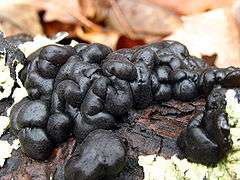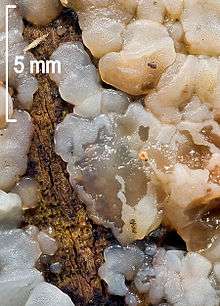Exidia
| Exidia | |
|---|---|
 | |
| Exidia glandulosa | |
| Scientific classification | |
| Kingdom: | Fungi |
| Phylum: | Basidiomycota |
| Class: | Agaricomycetes |
| Order: | Auriculariales |
| Family: | Auriculariaceae |
| Genus: | Exidia |
| Type species | |
| Exidia glandulosa (Bull.) Fr. | |
Exidia is a genus of fungi in the family Auriculariaceae. The species are saprotrophic, occurs in adhered or recently fallen dead wood and bloom as it grows to give another life opportunity to the fallen or deceased trunk, and produce [gelatinous basidiocarps]] (fruit bodies).The fruit bodies are diverse, pustular, lobed, button-shaped or cup-shaped. Several species, including the type species Exidia glandulosa , the genus has a cosmopolitan distribution and around 20 species are currently recognized worldwide.[1] Initial molecular research indicates the genus is artificial.[2]
Taxonomy
Species were originally placed in the genus Tremella along with many other gelatinous fungi. The genus Exidia was separated from Tremella by Fries in 1822, based mainly on fruitbody shape. Fries initially included species now assigned to Auricularia within the genus.
Recent molecular research has indicated that Exidia as currently circumscribed is an artificial grouping, species not being clearly differentiated from similar, but effused species assigned to the genera Exidiopsis and Heterochaete.[2] Only a few species have yet been sequenced, however.
Description
Fruit bodies are gelatinous, most having a distinct, spore-bearing, upper surface and a sterile undersurface. These surfaces are either smooth or (in some species) covered in dense or scattered, sterile pegs or pimples. Fruit bodies either grow separately or in clusters, when they may coalesce.
Microscopic characters
Fruit bodies are composed of hyphae with clamp connections in a gelatinous matrix. The spore-bearing surface is initially covered in a layer of branched hyphidia below which the basidia are formed. The basidia are tremelloid (ellipsoid and vertically septate), giving rise to long, sinuous sterigmata or epibasidia on which the basidiospores are produced. These spores are allantoid (sausage-shaped) or less commonly oblong to cylindrical.
Representative species

- Exidia aeruginosa
- Exidia alveolata
- Exidia cartilaginea
- Exidia glandulosa (synonym E. truncata)
- Exidia japonica
- Exidia nigricans (synonym E. plana)
- Exidia novozealandica
- Exidia pithya
- Exidia pusilla
- Exidia recisa
- Exidia repanda
- Exidia saccharina
- Exidia thuretiana
References
- ↑ Kirk PM, Cannon PF, Minter DW, Stalpers JA (2008). Dictionary of the Fungi (10th ed.). Wallingford: CABI. p. 250. ISBN 978-0-85199-826-8.
- 1 2 Weiss, M & Oberwinkler, F. (2001). Phylogenetic relationships in Auriculariales and related groups – hypotheses derived from nuclear ribosomal DNA sequences. Mycological Research 105: 403–415.